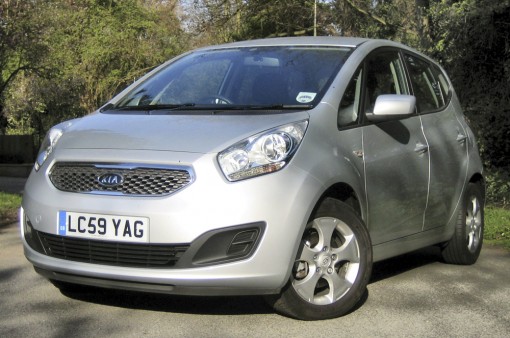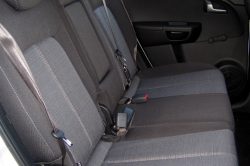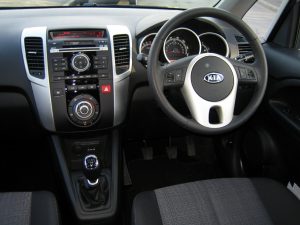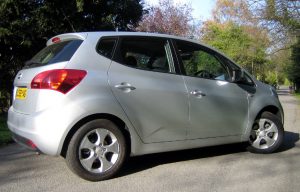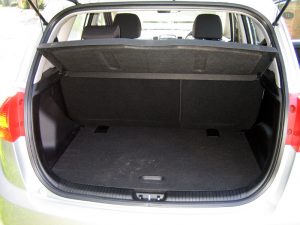Kia Venga 2 1.4 5-door
With clever design solutions, Kia’s new Venga isn’t as big as it looks. wheelworldreviews editor DAVID HOOPER drives one of the mid-range models.
THEY say all good things come in small packages, so it’s time to say hello to Kia’s Venga.
Its name may sound like some sort of cheesy dance you might find yourself doing on a package holiday after a couple of sangrias too many, but the car is cleverly styled.
It is the first new model to be designed from scratch by Peter Schreyer, Kia’s new chief designer who formerly drew Audis. It is aimed to attract people who are downsizing from larger, more costly and less environmentally friendly cars, but who want to do so in a “not too obvious” sort of way.
Thanks to its fairly tall architecture, the Venga doesn’t look like a small car, but is in fact only just over four metres long, yet inside will comfortably seat five adults and has a good sized boot which will swallow plenty of luggage. The amount of available boot space can be adjusted by sliding the rear seats forwards on runners, or folding down the seats, which disappear into the floor to create a flat load area. The boot floor can also be lowered to increase its capacity with the seats in place.
The Venga is built in the Czech Republic, specifically for the European market. There are three trim levels, Venga 1, Venga 2 and Venga 3, and with prices for the range starting at £11,495, I think it represents a value for money alternative to its competitors, especially when you consider that it comes with a seven year, 100,000-mile warranty.
The Venga has a choice of three engines and buyers can choose between a manual or automatic gearbox. The petrol engines consist of a 1.4-litre 89bhp unit or a more powerful 1.6-litre 124bhp engine. If you prefer diesel, that comes with a 1.4-litre capacity and Kia’s EcoDynamics technology, which helps to reduce C02 emissions by switching off the engine when the car comes to a halt and the gear lever is returned to the neutral position. It restarts when the clutch pedal is pressed down, ready to move off again. Kia says you can expect 62.9mpg in the combined cycle, and just 117g/km of C02, which means the BIK for company car drivers is 13% and your annual car tax costs £35.
Opening the door to the Venga and climbing inside, I was impressed with the overall look and feel of the interior. The instrumentation is clear, and all the knobs and buttons are laid out in a way that is quick to master. The heater controls looked a bit confusing at first, with the knobs for the temperature and fan speed stacked on top of each other, but they were easy enough to use.
There are also plenty of cup holders, and even the door pockets are a reasonable size.
The seating position is higher than you would find in most cars, which makes getting in and out of the car easier, especially for those who are not as supple as they once were, but once installed, the seats are comfortable and reasonably supportive. Plenty of glass means the interior is light and airy, more so if you go for the top of the range model, which comes with a panoramic glass roof as standard.
While the visibility through the large glass windscreen is good, the chunky “A” pillar does create a large blind spot, which means you have to make sure you have a good look around it as you approach junctions and roundabouts. It would be easy to “lose” a motorcyclist.
On the road, the car cruises quietly at speed on a decent road surface, but venture onto the concrete of the A180 and there’s plenty of road noise to be heard in the cabin.
The suspension set-up on the Venga is very firm, I thought overly so, which means you feel every little indiscretion in the road surface, and there are plenty of them – and after the winter we have just had there are quite a few big ones as well. Even with a full load of five adults in the car, the springs still offered plenty of resistance.
The 1.4-litre engine proved willing if a little raucous once the rev counter’s needle reached the 4,000rpm mark, but a lack of low-end torque means progress can be quite slow at the bottom end. A gear change indicator reminds you to change gear at the optimum time, although I think, occasionally, the car I tested was pulling my leg, advising me to change up, while travelling relatively slowly up hill. I followed its advice once to see what would happen when I was in what I thought to be the correct gear, and nearly stopped!
The Venga is well equipped and comes with air conditioning, driver’s seat height adjustment, electric front windows, remote central locking and tinted glass. There are also six airbags, active front head restraints and two Isofix child seat mounting points in the back, as well as plenty of electronic aids to keep the car and its occupants out of trouble.
The Venga is a well packaged, practical car which is easy on the eye and well priced – and with its seven-year whole car warranty, has to be worth a look.
THE VITAL STATISTICS
Kia Venga 2 1.4 5dr.
KIA VENGA RANGE: From 1 1.4 5dr (£11,495) to 3 1.4 CRDi EcoDynamics 5dr (£15,395).
ENGINE: 1396cc, 89bhp four-cylinder engine, driving front wheels through 5-speed manual gearbox.
CO2 EMISSIONS: 147g/km.
PERFORMANCE: Top speed 104mph. 0-62mph in 12.4 secs.
ECONOMY:
City: 37.7mpg.
Country: 51.4mpg.
Combined: 45.6mpg.
Fuel tank: 48 litres.
INSURANCE: Group 2.
WARRANTY: 7 years/100,000 miles.
PRICE: £12,695.
WEBSITE: www.kia.co.uk
- All data correct at time of publication.

